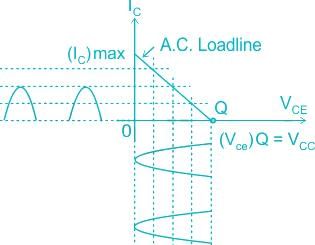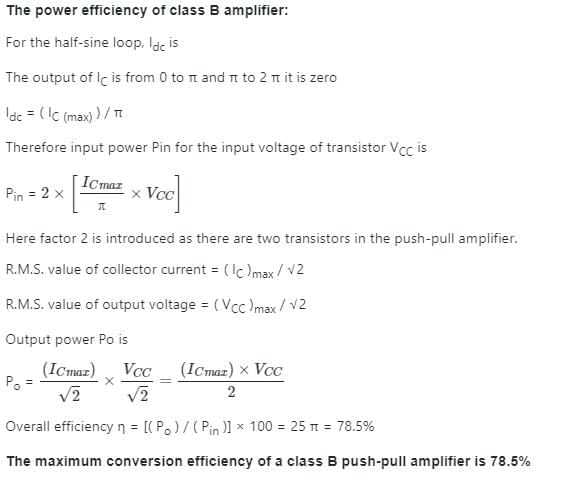Electronics and Communication Engineering (ECE) Exam > Electronics and Communication Engineering (ECE) Tests > Test: Push-Pull Class B Amplifier - Electronics and Communication Engineering (ECE) MCQ
Test: Push-Pull Class B Amplifier - Electronics and Communication Engineering (ECE) MCQ
Test Description
10 Questions MCQ Test - Test: Push-Pull Class B Amplifier
Test: Push-Pull Class B Amplifier for Electronics and Communication Engineering (ECE) 2025 is part of Electronics and Communication Engineering (ECE) preparation. The Test: Push-Pull Class B Amplifier questions and answers have been prepared
according to the Electronics and Communication Engineering (ECE) exam syllabus.The Test: Push-Pull Class B Amplifier MCQs are made for Electronics and Communication Engineering (ECE) 2025 Exam.
Find important definitions, questions, notes, meanings, examples, exercises, MCQs and online tests for Test: Push-Pull Class B Amplifier below.
Solutions of Test: Push-Pull Class B Amplifier questions in English are available as part of our course for Electronics and Communication Engineering (ECE) & Test: Push-Pull Class B Amplifier solutions in
Hindi for Electronics and Communication Engineering (ECE) course.
Download more important topics, notes, lectures and mock test series for Electronics and Communication Engineering (ECE) Exam by signing up for free. Attempt Test: Push-Pull Class B Amplifier | 10 questions in 30 minutes | Mock test for Electronics and Communication Engineering (ECE) preparation | Free important questions MCQ to study for Electronics and Communication Engineering (ECE) Exam | Download free PDF with solutions
Test: Push-Pull Class B Amplifier - Question 1
Which of these is not true for a class B amplifier?
Detailed Solution for Test: Push-Pull Class B Amplifier - Question 1
Test: Push-Pull Class B Amplifier - Question 2
How do we obtain sinusoidal output out of a class B amplifier?
Detailed Solution for Test: Push-Pull Class B Amplifier - Question 2
Test: Push-Pull Class B Amplifier - Question 3
The efficiency of a class B push-pull amplifier is
Detailed Solution for Test: Push-Pull Class B Amplifier - Question 3
Test: Push-Pull Class B Amplifier - Question 4
Read statements and select the correct option below.
A: A push-pull amplifier decreases harmonic distortion
B: Output has half-wave symmetry
Detailed Solution for Test: Push-Pull Class B Amplifier - Question 4
Test: Push-Pull Class B Amplifier - Question 5
Which of these is incorrect for complementary symmetry push-pull amplifiers?
Detailed Solution for Test: Push-Pull Class B Amplifier - Question 5
Test: Push-Pull Class B Amplifier - Question 6
What is the output of a class B amplifier for sinusoidal input?
Detailed Solution for Test: Push-Pull Class B Amplifier - Question 6
Test: Push-Pull Class B Amplifier - Question 7
In a class B amplifier, it is found that DC power is 25W, find the ac power.
Detailed Solution for Test: Push-Pull Class B Amplifier - Question 7
Test: Push-Pull Class B Amplifier - Question 8
What is the disadvantage of a class B push-pull amplifier?
Detailed Solution for Test: Push-Pull Class B Amplifier - Question 8
Test: Push-Pull Class B Amplifier - Question 9
Why does no DC current flow in the primary winding of the output transformer of class B push-pull amplifier?
Detailed Solution for Test: Push-Pull Class B Amplifier - Question 9
Test: Push-Pull Class B Amplifier - Question 10
Which is the main disadvantage of class B amplifiers?
Detailed Solution for Test: Push-Pull Class B Amplifier - Question 10
Information about Test: Push-Pull Class B Amplifier Page
In this test you can find the Exam questions for Test: Push-Pull Class B Amplifier solved & explained in the simplest way possible.
Besides giving Questions and answers for Test: Push-Pull Class B Amplifier, EduRev gives you an ample number of Online tests for practice
Download as PDF
















